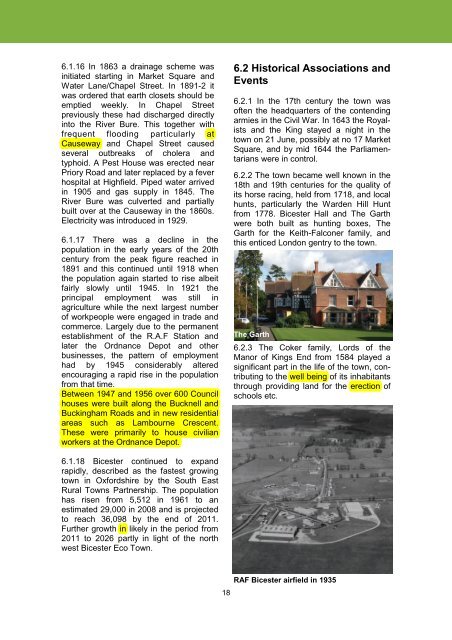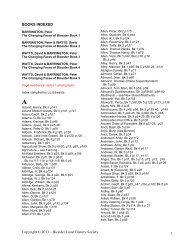Draft Bicester Conservation Area Appraisal November 2009
Draft Bicester Conservation Area Appraisal November 2009
Draft Bicester Conservation Area Appraisal November 2009
You also want an ePaper? Increase the reach of your titles
YUMPU automatically turns print PDFs into web optimized ePapers that Google loves.
6.1.16 In 1863 a drainage scheme wasinitiated starting in Market Square andWater Lane/Chapel Street. In 1891-2 itwas ordered that earth closets should beemptied weekly. In Chapel Streetpreviously these had discharged directlyinto the River Bure. This together withfrequent flooding particularly atCauseway and Chapel Street causedseveral outbreaks of cholera andtyphoid. A Pest House was erected nearPriory Road and later replaced by a feverhospital at Highfield. Piped water arrivedin 1905 and gas supply in 1845. TheRiver Bure was culverted and partiallybuilt over at the Causeway in the 1860s.Electricity was introduced in 1929.6.1.17 There was a decline in thepopulation in the early years of the 20thcentury from the peak figure reached in1891 and this continued until 1918 whenthe population again started to rise albeitfairly slowly until 1945. In 1921 theprincipal employment was still inagriculture while the next largest numberof workpeople were engaged in trade andcommerce. Largely due to the permanentestablishment of the R.A.F Station andlater the Ordnance Depot and otherbusinesses, the pattern of employmenthad by 1945 considerably alteredencouraging a rapid rise in the populationfrom that time.Between 1947 and 1956 over 600 Councilhouses were built along the Bucknell andBuckingham Roads and in new residentialareas such as Lambourne Crescent.These were primarily to house civilianworkers at the Ordnance Depot.6.2 Historical Associations andEvents6.2.1 In the 17th century the town wasoften the headquarters of the contendingarmies in the Civil War. In 1643 the Royalistsand the King stayed a night in thetown on 21 June, possibly at no 17 MarketSquare, and by mid 1644 the Parliamentarianswere in control.6.2.2 The town became well known in the18th and 19th centuries for the quality ofits horse racing, held from 1718, and localhunts, particularly the Warden Hill Huntfrom 1778. <strong>Bicester</strong> Hall and The Garthwere both built as hunting boxes, TheGarth for the Keith-Falconer family, andthis enticed London gentry to the town.The Garth6.2.3 The Coker family, Lords of theManor of Kings End from 1584 played asignificant part in the life of the town, contributingto the well being of its inhabitantsthrough providing land for the erection ofschools etc.6.1.18 <strong>Bicester</strong> continued to expandrapidly, described as the fastest growingtown in Oxfordshire by the South EastRural Towns Partnership. The populationhas risen from 5,512 in 1961 to anestimated 29,000 in 2008 and is projectedto reach 36,098 by the end of 2011.Further growth in likely in the period from2011 to 2026 partly in light of the northwest <strong>Bicester</strong> Eco Town.18RAF <strong>Bicester</strong> airfield in 1935



